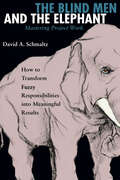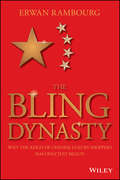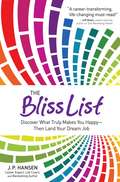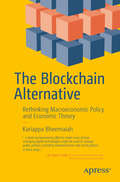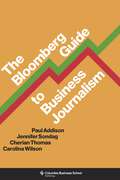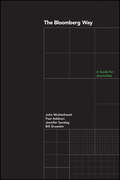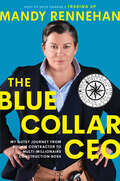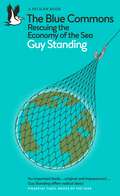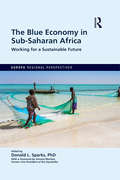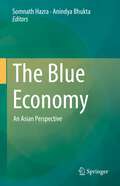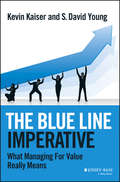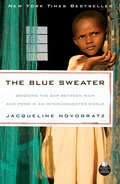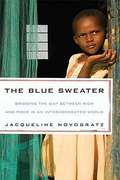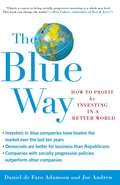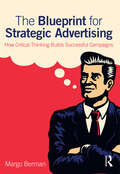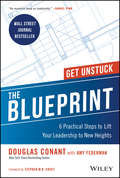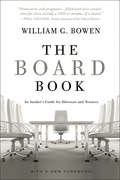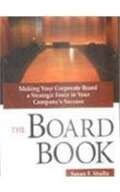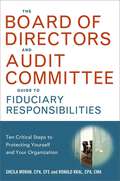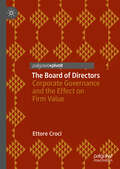- Table View
- List View
The Blind Decades
by Philippe AskenazyFrance is often described as one of the last Western economies unable to reform itself in the face of globalization. Yet its economy has not fallen by the wayside and has even resisted the great recession that began in 2008. By interlinking historical, economic, and political factors and by comparing France with other nations, this book explains the puzzle presented by the development of France. Understanding France's economy requires downplaying the usual policy injunctions--demands for less state control and less rigidity in the labor market--and instead stressing the importance of constructing a long-term industrial strategy.
The Blind Men and the Elephant: Mastering Project Work
by David A. SchmaltzIf you work, you probably manage projects every day-even if "project manager" isn't in your official title-and you know how frustrating the experience can be. Using the familiar story of six blind men failing to describe an elephant to each other as a metaphor, David Schmaltz brilliantly identifies the true root cause of the difficulties in project work: "incoherence" (the inability of a group of people to make common meaning from their common experience). Schmaltz exposes such oft-cited difficulties as poor planning, weak leadership, and fickle customers as poor excuses for project failure, providing a set of simple, project coherence-building techniques that anyone can use to achieve success. He explains how "wickedness" develops when a team over-relies on their leader for guidance rather than tapping their true source of power and authority-the individual. The Blind Men and the Elephant explores just how much influence is completely within each individual's control. Using real-world stories, Schmaltz undermines the excuses that may be keeping you trapped in meaningless work, offering practical guidance for overcoming the inevitable difficulties of project work.
The Bling Dynasty
by Erwan RambourgWhy the luxury market's fate rests in Chinese walletsThe media has negatively focused on the Chinese political administration clamping down on gifting. Observers have come to doubt the strength of Chinese consumption as the key driver for luxury. The Bling Dynasty illustrates how doubts about Chinese consumption are ill-founded and Chinese luxury demand is on the cusp of becoming dominant.This book contains the research and expert views companies need to understand and address the new challenges posed by this dominance. Each chapter brings a different perspective, covering complex aspects of luxury consumption, with illustrations and real-world examples that support the research. Readers will gain insights through interviews with brand executives, retailers, experts, and consumers.As an economic heavyweight, China is fast realizing its role in the luxury market. Chinese consumers should be accounting for more than a third of the global luxury market today, and half, if not more, in ten year's time. The Bling Dynasty runs counter to the conventional wisdom that expanding sectors become more global. Luxury is actually becoming over-dependent on Chinese sales.Readers will:Understand how Western brands developed in Asia and the challenges they are met with, notably ubiquityLearn why Chinese are purchasing luxury items abroad and what it means for the future of the sectorGain insights on why there are no Chinese luxury brands challenging Western modelsRealize that Chinese consumers are becoming similar to their American peers and that luxury competition goes way beyond pre-conceptionsChina's big spenders are increasingly mobile and this is affecting key markets. The Bling Dynasty provides new research and a comprehensive look at the booming business of luxury and the Chinese wallet.
The Bliss List
by J. P. HansenA practical and realistic guide to help you find passion in your career.What could be better than waking up every morning and looking forward to going to work? After all, most people spend the majority of their lives at work, and recent statistics reveal that four out of five people are "unhappy" in their current jobs. This is an epidemic J.P. Hansen calls The Whine Flu. The Bliss List is the cure. On a spiritual, conceptual, and practical level, The Bliss List will:* help you discover what makes you happy* help you identify skills you have and those you need to gain to achieve your goals* guide you through the important process of building a great résumé * provide actual interview questions--including off-the-wall ones--and offer the answers that nailed job offers * help you decide whether or not to accept a particular job offer when it comes along-- even if you think you must take it because you need the money
The Blockchain Alternative
by Kariappa BheemaiahExamine what would happen if we were to deploy blockchain technology at the sovereign level and use it to create a decentralized cashless economy. This book explains how finance and economics work today, and how the convergence of various technologies related to the financial sector can help us find solutions to problems, such as excessive debt creation, banks getting too big to fail, and shadow banking. The Blockchain Alternative offers sensible corrections to outdated and incorrect dogmas, such as the efficient markets hypothesis and rational expectations theory. You''ll also be introduced to universal basic income, the consequences of going cashless, why complexity economics needs to be understood and what kinds of tools and theories you''ll need to redefine the existing definition of capitalism. While the book does discuss technologies and methods that are primed for our future, a number of references are made to economic history and the works of great thinkers from a different era. You''ll see how the blockchain can be used to deploy solutions that were devised in the past, but which can serve as the antidote to our current economic malaises. You''ll discover that what is required today is not an adaptation of the old theories, but a new methodology that is suited to this new era. Without undertaking such an endeavor, one will always be burdened with a definition of capitalism that is out of kilter with the evolution of our digital humanity. What would this mean to monetary and fiscal policy, market structure and our current understanding of economics? More importantly would we need to change our current understanding of capitalism? And if we were to change our perceptions, what would the future version look like? This book answers these questions, and analyses some of the most pertinent issues of our generation. What You''ll Learn Examine fractional banking, debt, and the financialization of assets Gain a firm understanding of the "too big to fail" theory, smart contracts, and Fintech Review economics and agent-based modelling Use the blockchain and complexity economics to rethink economics and capitalistic systems Who This Book Is For The primary audience is bankers and other finance professionals, policy makers, and students of finance and economics. The secondary audience is anyone seeking a deeper understanding of the current financial system, the blockchain, and the future of capitalism. Praise for The Blockchain Alternative ". . . a bold and pioneering effort to make sense of how emerging digital technologies might be used to reshape public policies, including macroeconomic and social policies, in basic ways. Everyone interested in this very important emerging question should read this book. " - Dr. Sanjay G. Reddy, Associate Professor of Economics at The New School for Social Research and Research Associate of the Initiative for Policy Dialogue at Columbia University. "Writing on blockchain today is analogous to writing about the internet, before it became massively distributed. The book pushes us to think about the quantum leap that this technology may infer to our capitalist model, if scaled at the pace described by the book. Written with the support of strong empirical models but also with an open mind towards the future, this is a must read for anyone interested in becoming part of the new economic infrastructure" - Dr. Mark Esposito, Harvard University''s Division of Continuing Education & Judge Business School, University of Cambridge "With a rigorously balanced dosage of versatility and rationale we are allured into a multifaceted trajectory across ingrained yet functionally arcane economic models, only to plunge into a conceptually revolutionary realm which irreversibly stimulates us into envisaging a fascinating novel scheme of world order". - Ioana Surpateanu, Political Adviser to the European Parliament "If there is only one book that I am reading on how blockchain is going to change our lives, it will have to be "The Blockchain Alternativ...
The Blonde Salad
by Anat Keinan Vincent Dessain Kristina Maslauskaite Sandrine CrenerIn 2014, Chiara Ferragni, a globe-trotting founder of the world's most popular fashion blog The Blonde Salad, had to decide how to best monetize her blog as well as her shoe line called the "Chiara Ferragni Collection". A year earlier, Ferragni, together with her team, had already made a decision to transform her blog into an online lifestyle magazine and to build its positioning as a high-end brand. It meant that The Blonde Salad envisaged to only cooperate with a limited number of luxury fashion advertisers, inevitably reducing the blog's revenues. Ferragni considered changing the revenue-generating model by incorporating an online market place within The Blonde Salad, but which strategy and timeline would she need to achieve her aim? Should Ferragni's shoe line, a separate company with a different ownership structure, be merged with The Blonde Salad or was it desirable to keep the two apart?
The Bloomberg Guide to Business Journalism
by Jennifer Sondag Paul Addison Cherian Thomas Carolina WilsonThe Bloomberg Guide to Business Journalism provides students and professionals with the essential tools for reporting on companies, industries, financial markets, economies, banks, and government policies anywhere in the world. It illustrates how to chronicle capitalism for different audiences—from general consumers of business news to market specialists—and how to present compelling stories across print, web, video, and audio formats.At the heart of the book are exercises and explanations that demonstrate the most appropriate ways to cover a range of business topics. For those looking to begin careers as business journalists, the guide offers step-by-step instructions for reporting and breaking news, emphasizing high standards for accuracy and fairness. Readers will learn key questions to ask when interviewing executives, how to interpret a company financial statement, why markets move, and much more.An engaging and easy-to-understand storyline set in a fictional “Businessworld” accessibly conveys key concepts. The book offers clear advice on reporting, writing, editing, and producing multimedia content for today’s busy readers, listeners, and viewers. Chapters can be used for individual study or university instruction, and material can be customized for settings from a weeklong workshop to a full semester course.This authoritative book shows readers how to excel in business journalism and related communication fields at a time when the media landscape is changing rapidly and dramatically.
The Bloomberg Way: A Guide for Journalists
by John Micklethwait Bill Grueskin Jennifer Sondag Paul AddisonThe Bloomberg Way is the journalist's guide to covering business, finance and the economy, with authoritative guidance from the editor-in-chief and senior editors of Bloomberg. As the lines between objectivity and opinion become increasingly blurred, the new edition of the Bloomberg Way shows you how to be the first to publish print and multimedia content with accuracy and journalistic integrity. The authors walk through the best-practice reporting, writing and editing processes followed by this elite, global journalistic organization. You'll learn how to work effectively in a highly competitive real-time news environment where every second matters. The book offers expert tips for taking a story from pitch to publication, along with discussion of journalistic principles including fairness, transparency, sourcing, libel, privacy and ethics. The Bloomberg Way describes essential guidelines for producing content for print, broadcast and web audiences. <p><p> Topics include interviewing techniques, clarity and precision in writing and editing, compelling headlines and leads, the marriage of words and data in stories, effective charts and graphs, how to appear on television, writing for the web, and more. Each topic is accompanied by how-to examples and showcases useful functions from the Bloomberg Terminal. The Bloomberg Way also shows you how to collaborate with colleagues across platforms to report and present stories about: The stock, bond, commodity and currency markets. Companies, including earnings, mergers, debt, product strategy and management changes. Economies and their intersection with government and politics. The Bloomberg Way is the definitive book for any journalist or media specialist who needs to know how one of the world's leading news organizations covers news about business, finance and the economy.
The Blue Collar CEO: My Gutsy Journey from Rookie Contractor to Multi-Millionaire Construction Boss
by Mandy RennehanBorn in Yarmouth, Nova Scotia, Mandy Rennehan began her business career at age ten, catching bait and selling it to local fishermen. She was so good at her job, she was soon out-earning her father, a local lobster fisherman. At the age of seventeen, Rennehan decided to strike out on her own, so she packed a hockey bag and fled to Halifax, where she began cold-calling construction companies, volunteering to work for free so she could learn more about contracting and the trades. Three years later, Rennehan had garnered all the experience she needed to start her own company, Freshco, a boutique retail-maintenance and construction company. While Rennehan was still in her early twenties, her reputation as a knowledgeable and trustworthy contractor led to her first corporate contract with The Gap. Freshco has since become a multi-million-dollar company whose clients include Apple, Lululemon, Tiffany & Co., Sephora, Anthropologie, Nike and Home Depot, to name but a few. Known as “the blue-collar CEO” for her ability to seamlessly navigate between the white- and blue-collar worlds, Rennehan is a tireless advocate for the trades. Her savvy business skills and innovative thinking took her to the top of a male-dominated industry before she reached the age of thirty. This book is the “respectfully uncensored” story of how Rennehan succeeded in business through honesty, integrity and most of all, authenticity: by always remaining true to herself and her vision for success.
The Blue Commons: Rescuing the Economy of the Sea (Pelican Books)
by Guy StandingA FINANCIAL TIMES BEST ECONOMICS BOOK OF 2022 'A landmark book... The Blue Commons is at once a brilliant synthesis, a searing analysis, and an inspiring call to action.' - David Bollier'With remarkable erudition, passion and lyricism, Guy Standing commands the reader to wake up to the threat posed by rentier capitalism's violent policies for extraction, exploitation and depletion of that which is both common to us all, but also vital to our survival: the sea and all within it.' - Ann Pettifor 'Shines a bright light on the economy of the oceans, directing us brilliantly towards where a sustainable future lies.' - Danny Dorling'This is a powerful, visionary book - essential reading for all who yearn for a better world.' - Jason HickelThe sea provides more than half the oxygen we breathe, food for billions of people and livelihoods for hundreds of millions. But giant corporations are plundering the world's oceans, aided by global finance and complicit states, following the neoliberal maxim of Blue Growth. The situation is dire: rampant exploitation and corruption now drive all aspects of the ocean economy, destroying communities, intensifying inequalities, and driving fish populations and other ocean life towards extinction.The Blue Commons is an urgent call for change, from a campaigning economist responsible for some of the most innovative solutions to inequality of recent times. From large nations bullying smaller nations into giving up eco-friendly fishing policies to the profiteering by the Crown Estate in commandeering much of the British seabed, the scale of the global problem is synthesised here for the first time, as well as a toolkit for all of us to rise up and tackle it.The oceans have been left out of calls for a Green New Deal but must be at the centre of the fight against climate change. How do we do it? By building a Blue Commons alternative: a transformative worldview and new set of proposals that prioritise the historic rights of local communities, the wellbeing of all people and, with it, the health of our oceans.
The Blue Economy in Sub-Saharan Africa: Working for a Sustainable Future (Europa Regional Perspectives)
by Donald L. SparksThe blue economy, comprising coastal and marine resources, offers vast benefits for sub-Saharan Africa: of the 53 countries and territories in the region, 32 are coastal states; there are 13 million sq km of maritime zones; more than 90% of the region’s exports and imports come by sea; and the African Union hails the blue economy as the ‘new frontier of African renaissance’. Despite their importance, the region’s coastal and marine resources have been neither fully appreciated nor fully utilized. They are only now being recognized as being key to Africa’s potential prosperity. As the region grows, it has, in general, not taken adequate safeguards to protect these valuable resources. That is partly because some of the problems (pollution, for example) are regional and know no borders. All too often, short-term gains are made at the expense of the long term (overfishing, for example). This book provides, for the first time, a study of the constraints and opportunities the blue economy offers for sub-Saharan Africa. It includes an introduction and overview; sectoral analyses (including tourism, fisheries, mineral resources, culture, shipping and maritime safety); country case studies; and analyses of regional and international efforts towards better coastal zone and marine management.
The Blue Economy: An Asian Perspective
by Somnath Hazra Anindya BhuktaThis volume defines and analyzes the Blue Economy, a system that encompasses all the economic activities which are happening in and around the ocean within a sustainable development framework, with focus on countries in Asia. This work is timely, as Blue Economy activities account for a significant share of GDPs in the island and coastal economies in the Asia region, sustaining the livelihoods of one of the largest sections of the world's population. This book, therefore, assesses how the Blue Economy contributes to these livelihoods from economic and ecological perspectives and analyzes the various types of ecosystem services provided, and how these services are regulated and maintained. While most studies of the Blue Economy focus only on the economic aspects, this book provides ample statistical data to demonstrate why ecosystem services should additionally be considered for the estimation and valuation of the Blue economy. The book is primarily meant for researchers, students, and teachers in the fields of environmental and ocean economics, sustainable development, and ecosystem services, and will be of further interest to policymakers and government officials working in matters related to the Blue Economy and sustainability policy.
The Blue Line Imperative
by Kevin Kaiser S. David YoungA groundbreaking guide to making profitable business decisionsDo you wonder why your value initiatives aren't providing the payoff you'd hoped for? Could it be because you've been thinking about value all wrong? According to the authors of this groundbreaking guide, there's a very good chance that you have. Using examples from leading companies worldwide, they explain why every decision a company makes either creates value or detracts from it, and why, if they hope to survive and thrive in today's increasingly competitive global marketplace, company leaders must make value-creation the centrepiece of every business decision. Authors Kaiser and Young have dubbed this approach "Blue-Line Management," (BLM), and in this entertaining, highly accessible book, they delineate BLM principles and practices and show you how to implement them in your company.Explains why the failure to properly define and assess value often makes it difficult for the people who manage businesses to effect long-term successOffers guidelines for making the satisfaction of customer needs and wants--i.e. value creation--the driver of all business activitiesThe authors are respected academics at INSEAD, the world's largest and most respected graduate business school, with campuses in Europe, Asia and the Middle East
The Blue Line Imperative: What Managing for Value Really Means
by Kevin Kaiser S. David YoungA groundbreaking guide to making profitable business decisions Do you wonder why your value initiatives aren't providing the payoff you'd hoped for? Could it be because you've been thinking about value all wrong? According to the authors of this groundbreaking guide, there's a very good chance that you have. Using examples from leading companies worldwide, they explain why every decision a company makes either creates value or detracts from it, and why, if they hope to survive and thrive in today's increasingly competitive global marketplace, company leaders must make value-creation the centrepiece of every business decision. Authors Kaiser and Young have dubbed this approach "Blue-Line Management," (BLM), and in this entertaining, highly accessible book, they delineate BLM principles and practices and show you how to implement them in your company. Explains why the failure to properly define and assess value often makes it difficult for the people who manage businesses to effect long-term success Offers guidelines for making the satisfaction of customer needs and wants—i.e. value creation—the driver of all business activities The authors are respected academics at INSEAD, the world's largest and most respected graduate business school, with campuses in Europe, Asia and the Middle East
The Blue Sweater: Bridging the Gap Between Rich and Poor in an Interconnected World
by Jacqueline NovogratzThe Blue Sweater is the inspiring story of a woman who left a career in international banking to spend her life on a quest to understand global poverty and find powerful new ways of tackling it. It all started back home in Virginia, with the blue sweater, a gift that quickly became her prized possession—until the day she outgrew it and gave it away to Goodwill. Eleven years later in Africa, she spotted a young boy wearing that very sweater, with her name still on the tag inside. That the sweater had made its trek all the way to Rwanda was ample evidence, she thought, of how we are all connected, how our actions—and inaction—touch people every day across the globe, people we may never know or meet.From her first stumbling efforts as a young idealist venturing forth in Africa to the creation of the trailblazing organization she runs today, Novogratz tells gripping stories with unforgettable characters—women dancing in a Nairobi slum, unwed mothers starting a bakery, courageous survivors of the Rwandan genocide, entrepreneurs building services for the poor against impossible odds. She shows, in ways both hilarious and heartbreaking, how traditional charity often fails, but how a new form of philanthropic investing called "patient capital" can help make people self-sufficient and can change millions of lives. More than just an autobiography or a how-to guide to addressing poverty, The Blue Sweater is a call to action that challenges us to grant dignity to the poor and to rethink our engagement with the world.
The Blue Sweater: Bridging the Gap between Rich and Poor in an Interconnected World
by Jacqueline NovogratzThe Blue Sweater is the inspiring story of a woman who left a career in international banking to spend her life on a quest to understand global poverty and find powerful new ways of tackling it.
The Blue Way
by Joe Andrew Daniel De AdamsonTurning conventional wisdom on its head, The Blue Way shows why socially progressive companies that make political contributions to "blue" politicians and causes outperform "red" companies. The idea that progressives are better at businesses than conservatives will surprise most people - including many progressives. But as The Blue Way shows, in nearly every sector of the economy, blue companies are the top performers. As a result, an investor who places his money in stocks of blue companies will do better than one who chooses red companies or who chooses to invest in the market as a whole. In The Blue Way, Daniel Adamson and Joe Andrew, cofounders of Blue Investment Management, identify the companies that have the most progressive social values - fair wages, equal opportunity, environmental responsibility - and also contribute to progressive political causes (or are at least neutral). They describe the portfolio they have built around those companies, which to date has out-performed the market. Their innovative investment strategy offers a profitable approach for investors seeking a principled and successful stock portfolio. But The Blue Way is also a stirring manifesto, a call to embrace socially and politically progressive values. As the authors show, these values aren't anti-business; they are pro-American. For decades the American economy has performed better under Democratic administrations than under Republicans. Americans who "buy blue," say Adamson and Andrew, aren't just acting on their values; they are helping to grow the American economy. The authors explain how to build a "blue infrastructure," a progressive ecosystem in which companies and activists with progressive values can support blue politicians and causes. The Blue Way shows how the progressive movement can learn from the success of the blue business world and create a new progressive majority for the future. The Blue Way describes a revolutionary investment strategy back by solid financial research that benefits investors while fostering socially progressive American values.
The Blueprint for Strategic Advertising: How Critical Thinking Builds Successful Campaigns
by Margo BermanThe Blueprint for Strategic Advertising’s step-by-step approach takes a comprehensive and exclusive look into the strategic use of visual, verbal, social media, integrated, and global of advertising communication. Its deconstructive process analyzes one aspect at a time, creating an invaluable research tool that students, professors, small business owners and entrepreneurs will refer to, time and again. This useful guide will concentrate on how strategy is integrated into visual and verbal ideation. Berman’s compact, content-rich guide offers chapters detailing social media, user-centered interactive advertising, and presentation strategy, closing with the creation of a "blueprint" to strategizing globally. Features include a handy reference guide to powerful strategizing, an exploration of strategies for myriad media and messaging vehicles, and an examination of the strategic implementation of the visual and verbal union. This guide will be useful to students in advertising, marketing, and business courses as well as advertising professionals and entrepreneurs, outside the classroom.
The Blueprint: 6 Practical Steps to Lift Your Leadership to New Heights
by Douglas R. ConantLift your leadership to new heightsDoug Conant, Founder of ConantLeadership, former CEO of Campbell Soup Company, and former President of Nabisco Foods, shares transformational insights in his new book, The Blueprint. Conant is the only former Fortune 500 CEO who is a New York Times bestselling author, a top 50 Leadership Innovator, a Top 100 Leadership Speaker, and a Top 100 Most Influential Author in the World. Get Unstuck In 1984, Doug Conant was fired without warning and with barely an explanation. He felt hopeless and stuck but, surprisingly, this defeating turn of events turned out to be the best thing that ever happened to him. Doug began to consider what might be holding him back from realizing his potential, fulfilling his dreams, and making a bigger impact on the world around him. Embarking on a journey of self-reflection and discovery, he forged a path to revolutionize his leadership and transform his career trajectory. Ultimately, Doug was able to condense his remarkable leadership story into six practical steps. It wasn't until Doug worked through these six steps that he was able to lift his leadership to heights that ultimately brought him career success, joy, and fulfillment. Reach High - Envision Dig Deep - Reflect Lay the Groundwork - Study Design - Plan Build - Practice Reinforce - Improve In The Blueprint, part leadership manifesto, part practical manual, Doug teaches leaders how to work through the same six steps that he used to transform his journey. The six steps are manageable and incremental, designed to fit practically within the pace of busy modern life. Knowing how daunting the prospect of change can be, Doug arms readers with exercises and practices to realistically bring their foundation to life in every situation. Now, today’s leaders who feel stuck and overwhelmed finally have a blueprint for lifting their leadership to make meaningful change in their organizations and in the world.
The Board Book: An Insider's Guide for Directors and Trustees
by William G. Bowen"By far the best book on corporate and institutional governance." --Nicholas Katzenbach, former attorney general of the United States In his new foreword to The Board Book, former Mellon Foundation and Princeton University president William G. Bowen brings his immense experience to bear on the most pressing questions facing boards of directors and trustees today: seeking collaborative relationships and placing a renewed emphasis on sustainable initiatives. The strategies Bowen relates throughout the book foster the collegiality and sense of purpose--more important in today's turbulent times than ever before--that are integral to any effective board.
The Board Book: Making Your Corporate Board a Strategic Force in Your Company's Success
by Susan F. ShultzThe Board Book is the most succinct, reader-friendly guide available to recruiting and managing on-track, top-notch corporate boards.
The Board and the CEO: Seven Practices to Protect Your Organization's Most Important Relationship
by Peter Greer David Weekley Tiger DawsonGood relationships lie at the heart of every successful organization. Yet no relationship is more important—or more challenging—to navigate than the one between the board and the CEO. In this practical and concise book, Peter Greer and David Weekley draw from their years of experience to equip board members and organizational leaders to enter into an impactful, life-giving partnership. With this pivotal relationship in place, individuals and the organizations they serve can truly flourish.
The Board of Directors and Audit Committee Guide to Fiduciary Responsibilities: Ten Crtical Steps to Protecting Yourself and Your Organization
by Ronald Kral Sheila MoranMore than three million people serve on boards and audit committees in the U.S. alone. But huge risks come with these coveted jobs. SEC scrutiny is at an all-time high, with boards and audit committees now held liable to for acts of fraud and other corporate malfeasance--even if they had no knowledge of wrong-doing in the organization. This essential guide mitigates the risks and dramatically increases the effectiveness of boards and audit committees by uncovering 10 crucial steps every governing body should take, including: * Cultivate independence * Build a balanced team * Leverage independent advisors * Address stakeholder concerns * Direct the external audit * Approach risk proactively * Spearhead fraud deterrence initiatives * Promote accountability * And more Comprehensive and practical, this book simplifies complex corporate governance standards, and helps readers satisfy the requirements of board service while protecting themselves and the organization.
The Board of Directors at Market Basket
by Jay W. Lorsch Emily MctagueThe firing of Market Basket CEO Arthur T. Demoulas by his cousin, Arthur S. Demoulas, and directors affiliated with Arthur set off employee protests throughout the grocery store chain. Industry specialists estimated that Market Basket was losing close to $10 million each day in lost business and inventory, due to the protests. A long history of legal battles had destroyed the relationship between the families of the 2 cousins. This case describes the complexities of corporate governance for a family-owned organization.
The Board of Directors: Corporate Governance and the Effect on Firm Value
by Ettore CrociBoards of directors are a central feature of any corporate governance regime. The role of directors and how they affect firm value and policies is examined in depth in academic literature. However, it is easy to get both lost and overwhelmed when searching through the literature review that investigates several characteristics, often one at the time. This book provides a careful and concise look at corporate finance literature, specifically with regard to the board of directors, summarizing the main findings and reconciling them. This book documents the pros and cons associated with the various attributes of the board and the directors as found in the current literature and provides sections geared specifically to practitioners in this space, as well, allowing for a better and more comprehensive description of this important corporate governance mechanism. The resulting book aims to facilitate the interpretation of changes in corporate governance through the lens of the recent academic literature.

